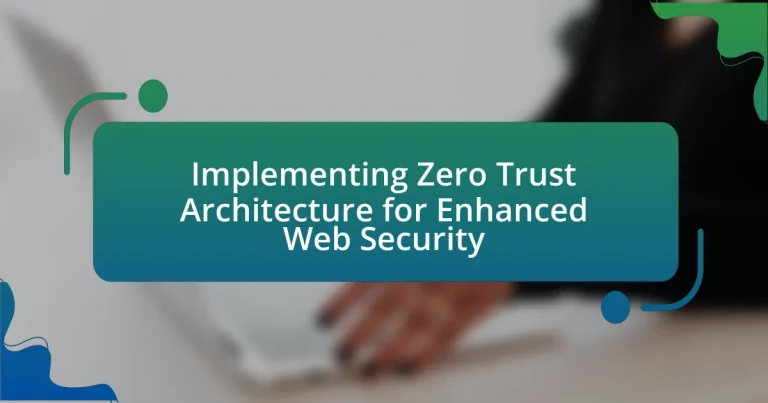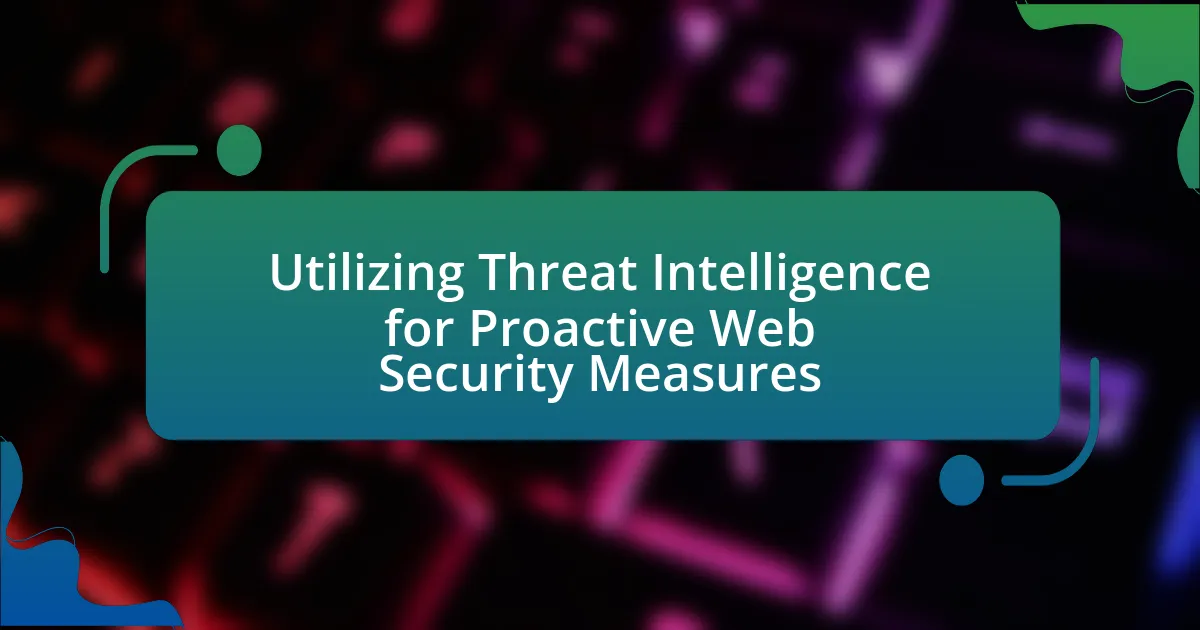Zero Trust Architecture (ZTA) is a security model that mandates strict identity verification for all users and devices accessing network resources, regardless of their location. This article outlines the fundamental differences between Zero Trust and traditional security models, emphasizing the importance of continuous verification and the principle of “never trust, always verify.” Key components of ZTA, such as identity verification, least privilege access, and continuous monitoring, are discussed, along with the technologies that support its implementation. The article also addresses the challenges organizations face during the transition to Zero Trust, including user resistance and integration with existing systems, while providing best practices for successful implementation and measuring security improvements. Finally, it explores future trends and the role of emerging technologies, such as artificial intelligence, in enhancing Zero Trust strategies for web security.

What is Zero Trust Architecture?
Zero Trust Architecture is a security model that requires strict identity verification for every person and device attempting to access resources on a network, regardless of whether they are inside or outside the network perimeter. This approach is based on the principle of “never trust, always verify,” which means that no user or device is automatically trusted, and access is granted only after thorough authentication and authorization processes. The effectiveness of Zero Trust Architecture is supported by the increasing number of cyber threats and data breaches, which have shown that traditional perimeter-based security is insufficient. According to a 2021 report by Cybersecurity Insiders, 76% of organizations are adopting Zero Trust to enhance their security posture.
How does Zero Trust Architecture differ from traditional security models?
Zero Trust Architecture (ZTA) fundamentally differs from traditional security models by adopting a “never trust, always verify” approach, which assumes that threats can exist both inside and outside the network. Traditional security models typically rely on perimeter defenses, trusting users and devices within the network once they are authenticated. In contrast, ZTA requires continuous verification of user identities and device security, regardless of their location, thereby minimizing the risk of insider threats and lateral movement within the network. This shift is supported by the increasing complexity of cyber threats and the rise of remote work, which necessitate a more robust security framework that does not solely depend on perimeter defenses.
What are the key principles of Zero Trust Architecture?
The key principles of Zero Trust Architecture include the following: verifying every user and device, enforcing least privilege access, and continuously monitoring and validating trust. Verifying every user and device ensures that access is granted only after authentication, regardless of location. Enforcing least privilege access limits user permissions to only what is necessary for their role, reducing potential attack surfaces. Continuously monitoring and validating trust involves ongoing assessment of user behavior and device health to detect anomalies and respond to threats in real-time. These principles collectively enhance security by assuming that threats can exist both inside and outside the network perimeter.
Why is the concept of “never trust, always verify” crucial?
The concept of “never trust, always verify” is crucial because it establishes a security framework that minimizes the risk of unauthorized access and data breaches. In an era where cyber threats are increasingly sophisticated, relying solely on traditional perimeter defenses is inadequate. This principle mandates continuous verification of user identities and device integrity, regardless of their location within or outside the network. For instance, according to a 2020 report by Cybersecurity Insiders, 70% of organizations have adopted a Zero Trust model to enhance their security posture, demonstrating the effectiveness of this approach in mitigating risks associated with insider threats and compromised credentials.
What are the main components of Zero Trust Architecture?
The main components of Zero Trust Architecture include identity verification, device security, network segmentation, least privilege access, and continuous monitoring. Identity verification ensures that users are authenticated and authorized before accessing resources, while device security involves assessing the security posture of devices attempting to connect to the network. Network segmentation limits access to sensitive data and systems, reducing the attack surface. Least privilege access grants users only the permissions necessary for their roles, minimizing potential damage from compromised accounts. Continuous monitoring involves real-time analysis of user behavior and network traffic to detect anomalies and respond to threats promptly. These components collectively reinforce a security model that assumes no implicit trust, thereby enhancing overall web security.
How do identity and access management play a role in Zero Trust?
Identity and access management (IAM) is crucial in Zero Trust as it ensures that only authenticated and authorized users can access resources. In a Zero Trust model, IAM enforces strict identity verification processes, such as multi-factor authentication, to confirm user identities before granting access. This approach minimizes the risk of unauthorized access and data breaches, as it operates on the principle of “never trust, always verify.” According to a 2021 report by Forrester Research, organizations implementing Zero Trust frameworks with robust IAM practices saw a 50% reduction in security incidents, highlighting the effectiveness of IAM in enhancing security within Zero Trust architectures.
What technologies support the implementation of Zero Trust?
Technologies that support the implementation of Zero Trust include identity and access management (IAM), multi-factor authentication (MFA), micro-segmentation, endpoint security, and security information and event management (SIEM). IAM solutions ensure that only authorized users can access specific resources, while MFA adds an additional layer of security by requiring multiple forms of verification. Micro-segmentation allows for the isolation of network segments to limit lateral movement within the network, enhancing security. Endpoint security protects devices that connect to the network, and SIEM provides real-time analysis of security alerts generated by applications and network hardware. These technologies collectively create a robust framework for enforcing Zero Trust principles.
What challenges are associated with implementing Zero Trust Architecture?
Implementing Zero Trust Architecture presents several challenges, including complexity in deployment, integration with existing systems, and user resistance. The complexity arises from the need to redefine security policies and continuously monitor user behavior, which can overwhelm organizations lacking the necessary expertise. Integration challenges occur as legacy systems may not support Zero Trust principles, requiring significant investment in new technologies or upgrades. User resistance is often driven by the perception of increased friction in accessing resources, as Zero Trust mandates strict verification for every access attempt. These challenges are documented in industry reports, such as the 2021 “Zero Trust Adoption Report” by Cybersecurity Insiders, which highlights that 77% of organizations face difficulties in implementation due to these factors.
How can organizations overcome resistance to change during implementation?
Organizations can overcome resistance to change during implementation by fostering open communication and involving employees in the change process. Engaging staff through transparent discussions about the reasons for the change, such as the need for enhanced security in implementing Zero Trust Architecture, helps to alleviate fears and misconceptions. Research indicates that organizations that actively involve employees in decision-making processes experience a 70% higher success rate in change initiatives. Additionally, providing training and support can empower employees, making them feel more competent and confident in adapting to new systems.
What are the potential costs involved in transitioning to Zero Trust?
The potential costs involved in transitioning to Zero Trust include technology investments, personnel training, and ongoing operational expenses. Organizations must allocate funds for new security tools, such as identity and access management systems, network segmentation solutions, and continuous monitoring technologies, which can range from tens of thousands to millions of dollars depending on the scale. Additionally, training staff to understand and implement Zero Trust principles incurs costs related to both time and resources, as employees need to be educated on new protocols and tools. Ongoing operational expenses may also arise from maintaining and updating these systems, as well as potential increases in IT staffing to manage the more complex security environment. According to a study by Forrester Research, organizations can expect to spend an average of 30% more on security solutions during the transition to a Zero Trust model compared to traditional security frameworks.
How does Zero Trust Architecture enhance web security?
Zero Trust Architecture enhances web security by enforcing strict access controls and continuous verification of users and devices. This model operates on the principle of “never trust, always verify,” meaning that every access request is authenticated and authorized regardless of its origin, whether inside or outside the network perimeter. By segmenting networks and applying least privilege access, Zero Trust minimizes the attack surface and limits lateral movement within the network. According to a 2021 report by Cybersecurity Insiders, organizations implementing Zero Trust have seen a 50% reduction in security breaches, demonstrating its effectiveness in enhancing web security.
What are the specific benefits of Zero Trust for web applications?
The specific benefits of Zero Trust for web applications include enhanced security, reduced attack surface, and improved compliance. Enhanced security is achieved through continuous verification of user identities and device health, ensuring that only authenticated users can access sensitive data. Reduced attack surface occurs as Zero Trust limits access to resources based on the principle of least privilege, minimizing potential entry points for attackers. Improved compliance is facilitated by detailed access logs and monitoring, which help organizations meet regulatory requirements. According to a 2021 study by Forrester Research, organizations implementing Zero Trust reported a 50% reduction in security breaches, demonstrating its effectiveness in protecting web applications.
How does Zero Trust reduce the risk of data breaches?
Zero Trust reduces the risk of data breaches by enforcing strict access controls and continuous verification of users and devices. This security model operates on the principle of “never trust, always verify,” meaning that every access request is authenticated and authorized regardless of its origin. According to a 2021 report by Cybersecurity Insiders, organizations implementing Zero Trust experienced a 50% reduction in data breaches compared to those using traditional security models. By segmenting networks and limiting access to sensitive data, Zero Trust minimizes the attack surface and prevents unauthorized access, thereby significantly lowering the likelihood of data breaches.
What role does continuous monitoring play in web security under Zero Trust?
Continuous monitoring is essential in web security under Zero Trust as it enables real-time visibility into user activities and system vulnerabilities. This approach ensures that all access requests are continuously evaluated against security policies, allowing for immediate detection of anomalies or unauthorized actions. According to a study by Forrester Research, organizations implementing continuous monitoring within a Zero Trust framework can reduce the risk of data breaches by up to 50%. This proactive stance not only enhances threat detection but also facilitates rapid response to potential security incidents, thereby reinforcing the overall security posture of the organization.
What best practices should organizations follow when implementing Zero Trust?
Organizations should follow several best practices when implementing Zero Trust, including defining a clear security perimeter, continuously verifying user identities, and segmenting networks. Establishing a security perimeter involves identifying critical assets and ensuring that access is restricted based on the principle of least privilege. Continuous verification of user identities can be achieved through multi-factor authentication and real-time monitoring of user behavior, which helps to detect anomalies. Network segmentation further enhances security by isolating sensitive data and systems, reducing the attack surface. According to a 2021 Forrester report, organizations that adopted Zero Trust saw a 50% reduction in security breaches, demonstrating the effectiveness of these practices.
How can organizations effectively assess their current security posture?
Organizations can effectively assess their current security posture by conducting comprehensive security assessments that include vulnerability scans, penetration testing, and risk assessments. These methods allow organizations to identify weaknesses in their systems and processes, enabling them to prioritize remediation efforts. For instance, a 2021 report by the Ponemon Institute found that organizations that regularly conduct security assessments reduce their risk of data breaches by up to 50%. Additionally, leveraging frameworks such as the NIST Cybersecurity Framework can provide structured guidance for evaluating security measures and aligning them with best practices.
What steps should be taken to ensure a successful Zero Trust implementation?
To ensure a successful Zero Trust implementation, organizations should follow these steps: first, assess the current security posture and identify critical assets, which establishes a baseline for security needs. Next, implement strict identity and access management protocols, ensuring that users are authenticated and authorized before accessing resources. Additionally, continuously monitor and analyze network traffic to detect anomalies, which helps in identifying potential threats in real-time. Finally, regularly update and patch systems to mitigate vulnerabilities, as outdated software can be an entry point for attacks. These steps are supported by the principle that Zero Trust operates on the assumption that threats can exist both inside and outside the network, necessitating a comprehensive approach to security.
What common pitfalls should organizations avoid in Zero Trust implementation?
Organizations should avoid the common pitfalls of inadequate planning, insufficient user education, and neglecting to integrate existing security tools in Zero Trust implementation. Inadequate planning can lead to misalignment between business objectives and security measures, resulting in ineffective security postures. Insufficient user education can cause resistance to new protocols, undermining the effectiveness of Zero Trust principles. Neglecting to integrate existing security tools can create gaps in security coverage, as a cohesive approach is essential for a successful Zero Trust framework. These pitfalls can hinder the overall effectiveness of Zero Trust strategies, as evidenced by studies indicating that organizations with comprehensive planning and user engagement experience significantly lower security incidents.
How can misconfigurations impact the effectiveness of Zero Trust?
Misconfigurations can severely undermine the effectiveness of Zero Trust by creating vulnerabilities that attackers can exploit. In a Zero Trust model, every access request is verified, but if configurations are incorrect, legitimate users may gain excessive permissions or unauthorized access may go unchecked. For instance, a study by the Cybersecurity and Infrastructure Security Agency (CISA) highlighted that 70% of breaches stem from misconfigurations, indicating that even minor errors can lead to significant security risks. Therefore, ensuring accurate configurations is critical to maintaining the integrity of a Zero Trust architecture.
What are the risks of inadequate user training in a Zero Trust environment?
Inadequate user training in a Zero Trust environment significantly increases the risk of security breaches. Users who lack proper training may fail to recognize phishing attempts, leading to unauthorized access to sensitive data. According to a report by the Ponemon Institute, human error is a leading cause of data breaches, accounting for 23% of incidents. Additionally, without understanding the principles of Zero Trust, users may inadvertently bypass security protocols, exposing the organization to threats. This lack of awareness can result in compromised credentials and increased vulnerability to insider threats, ultimately undermining the effectiveness of the Zero Trust model.
How can organizations measure the success of their Zero Trust Architecture?
Organizations can measure the success of their Zero Trust Architecture by evaluating key performance indicators (KPIs) such as incident response time, the number of security breaches, user access patterns, and compliance with security policies. For instance, a reduction in the average time to detect and respond to security incidents indicates improved security posture, while a decrease in unauthorized access attempts reflects effective identity and access management. Additionally, organizations can assess user experience metrics to ensure that security measures do not hinder productivity. Regular audits and assessments against compliance frameworks, such as NIST or ISO standards, provide further validation of the Zero Trust implementation’s effectiveness.
What metrics should be tracked to evaluate security improvements?
To evaluate security improvements, organizations should track metrics such as the number of detected security incidents, the time to detect and respond to threats, and the percentage of systems compliant with security policies. Monitoring the number of vulnerabilities identified and remediated, as well as user access patterns and authentication failures, also provides insight into security posture. These metrics are essential as they directly reflect the effectiveness of security measures implemented under a Zero Trust Architecture, which emphasizes continuous monitoring and verification of user identities and device security. For instance, a study by Forrester Research indicates that organizations adopting Zero Trust can reduce the average time to detect a breach by 50%, highlighting the importance of these metrics in assessing security improvements.
How can feedback loops enhance the Zero Trust strategy over time?
Feedback loops can enhance the Zero Trust strategy over time by continuously refining security policies based on real-time data and user behavior analytics. This iterative process allows organizations to identify vulnerabilities and adapt their security measures proactively, ensuring that access controls remain effective against evolving threats. For instance, according to a study by Forrester Research, organizations that implement feedback mechanisms report a 30% reduction in security incidents, demonstrating the effectiveness of adaptive security measures in a Zero Trust framework.
What are the future trends in Zero Trust Architecture for web security?
Future trends in Zero Trust Architecture for web security include increased adoption of identity-centric security models, enhanced automation through AI and machine learning, and a focus on continuous monitoring and analytics. Organizations are shifting towards identity as the new perimeter, emphasizing user authentication and authorization to mitigate risks. According to a report by Gartner, by 2025, 70% of organizations will adopt a Zero Trust model, reflecting a significant shift in security strategies. Additionally, the integration of AI will facilitate real-time threat detection and response, making security measures more proactive. Continuous monitoring will also become essential, as it allows organizations to adapt to evolving threats and maintain compliance with regulations.
How might emerging technologies influence Zero Trust strategies?
Emerging technologies significantly influence Zero Trust strategies by enhancing security measures through advanced authentication, real-time monitoring, and automated responses. For instance, artificial intelligence and machine learning enable organizations to analyze user behavior patterns, allowing for more accurate risk assessments and anomaly detection. According to a report by Gartner, organizations implementing AI-driven security solutions can reduce incident response times by up to 90%. Additionally, the integration of blockchain technology can improve data integrity and access control, further reinforcing Zero Trust principles. These technologies collectively enable a more adaptive and resilient security posture, essential for protecting sensitive data in increasingly complex digital environments.
What role will artificial intelligence play in the evolution of Zero Trust?
Artificial intelligence will play a crucial role in the evolution of Zero Trust by enhancing threat detection and response capabilities. AI algorithms can analyze vast amounts of data in real-time, identifying anomalies and potential security breaches that traditional methods may overlook. For instance, according to a report by Gartner, organizations that implement AI-driven security solutions can reduce incident response times by up to 90%. This capability allows for continuous monitoring and adaptive security measures, which are fundamental principles of Zero Trust architecture. Additionally, AI can automate user behavior analytics, ensuring that access controls are dynamically adjusted based on real-time risk assessments, thereby reinforcing the Zero Trust model.
What practical steps can organizations take to start implementing Zero Trust?
Organizations can start implementing Zero Trust by defining a clear security policy that includes strict access controls and continuous verification of user identities. This involves segmenting the network to limit access to sensitive data and resources, ensuring that users only have access to what they need for their roles. Additionally, organizations should deploy multi-factor authentication (MFA) to enhance user verification and utilize encryption for data in transit and at rest. Regular monitoring and logging of user activities are essential to detect anomalies and respond to potential threats. According to a 2021 report by Forrester Research, organizations that adopt Zero Trust principles can reduce the risk of data breaches by up to 50%, highlighting the effectiveness of these practical steps.




